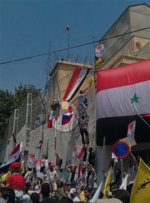Syrian Protesters using Russian flags?
 A Russian flag in the center spotlight (click to enlarge)Early this week brazen pro-government mobs attacked the American and French embassies in Damascus. The assault left three French nationals injured and showed the increasing desperation of the Syrian regime in framing the narrative on unrest in Syria. The attacks have already drawn condemnation from the United States and the United Nations.
A Russian flag in the center spotlight (click to enlarge)Early this week brazen pro-government mobs attacked the American and French embassies in Damascus. The assault left three French nationals injured and showed the increasing desperation of the Syrian regime in framing the narrative on unrest in Syria. The attacks have already drawn condemnation from the United States and the United Nations.
The attack was sparked by a visit from American Ambassador Robert Ford and his French counterpart, Eric Chevallier, to the city of Hama in central Syria last Friday. There they met with anti-government protesters who warmly greeted them.
One seemingly bizarre detail from reports of the riot suggests that the Russian flags were carried by some protesters mixed in of course with the pictures of Syrian President Bashar Al-Assad and of course Syrian flags.
Ironically, the Arab Spring has in part revealed just how far diminished Russian influence is in the region. This is perhaps best represented by muddled response from Russia and the open disagreement between Russian President Dmitry Medvedev and Prime Minister Vladmir Putin on Libya. The Soviet Union was once an important player in the Middle Eastern geopolitics but, the Russian Federation has far less influence in the region. (Though in the past decade, Chechen political leaders and insurgents have met mysterious deaths in the region.)
One clear exception however is the Russian-Syrian relations which has remained particularly warm. The Russian military has also long had plans to upgrade its rusting Cold War-era facility at the Syrian port of Tartus. Russian naval planners believe a naval facility at Tartus would both establish a permanent Russian presence in the Mediterranean and serve a support role for ongoing anti-piracy efforts. As the Syrian protests continue to build, Russia has been perceived as blocking a UN resolution on Syria. This is perhaps why the Russian flag is now the flag of choice in Damascus.
Indeed, the Russian flag is increasingly the banner of choice for angry mobs that choose to violate the standards of the 1961 Vienna Convention and attack embassies. In 2008, the American Embassy in Belgrade was set ablaze following American recognition of Kosovo as an independent state. Allegedly Serbian protestors also carried the Russian banner with them during this attack.
This latest incident however will likely bring into question the Obama Administration's wisdom in dispatching Ambassador Ford to Syria in the first place. This is not the first time that embassies of foreign nations in Damascus have become political pawns serving the interests of the Assad regime.
In September 2006, Syria guards killed and captured would be car-bombers on the U.S embassy in Damascus. The Syrian government used the incident to suggest that US policy in the Middle East was increasing terrorism. Despite coming on the heels of the 2006 Israel-Hizbullah war, the incident was largely buried in the back pages of the international newspapers. The Syrian response earned grudging praise from the administration of then President George W. Bush.
Earlier that same year the Danish and Norwegian embassies were set ablaze in riots following the publication of now infamous cartoons in in the Danish Jyllands Posten. Syria along with Libya witnessed some of the worst violence in the region following the publications of the offensive cartoons.
